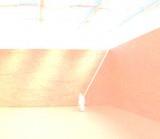Supervisor:
Architectural Technology
2008
The present research, aims to the evaluation of the physical scale model as a representative tool on lighting studies, through the approach of the subject on theoretical level as well as on a construction level and the use of model for qualitative and quantitative evaluation of the lighting conditions in a specific space. The main goal of the study is the verification of the importance of representation of lighting in a specific space during the process of design with the essential help of dependable tools based on the function of the human visual system and the human perception. In this point, a comparative study of the model and the software of lighting relatively to the quality of representation and plausibility are presented.
In order to fulfill the above aims, “shed” light to the subject and finally come to conclusions, the need for a study on the characteristics of natural light emerged as an essential issue. The research treats, apart from light’s behavior to the surrounding objects, the way of human perception of its countenance. In addition there is a need for researching the different methods of studying natural light and its important role on the design quality, the preserving of energy and the quality of life.
The place that is chosen for the representation of lighting conditions, through a scale model, is a Byzantine monument in the area of Larissa. “Bezesteni”, an ancient marketplace, is an orthogonal building with destroyed roof. Inside the framework of the research a system of covering and interior lighting is developed after studying definite alternative cases. As a theoretical background, different strategies and systems of natural lighting are worked out and factors of lighting performance are considered. Taking in mind the future use of the building under study as a Byzantine museum, the basic patters of lighting of exhibition places are examined. The limitations of the intensity and the way which lighting is used are highly considered since the protection of the exhibitory is an important issue.
After the construction of the model, measurements with the necessary tools, heliodon and artificial sky, are taking place. The qualitative evaluation of the lighting conditions as well as the qualitative utilization through photographing is the measurements’ objectives. The existent studies evince that models tend to an overvaluation of the lighting levels in relation to the real conditions. In the specific case, the comparison is not attainable and consequently the conclusions for the attribution of the mean to approach the real condition are not feasible.
In the present study the familiarization to the process of measurement and the method of using model as a tool of representation is ventured, through the evaluation of different choices of lighting. Also main objective is expanding the cognition on the strategies of utilization and exploitation of natural light.
